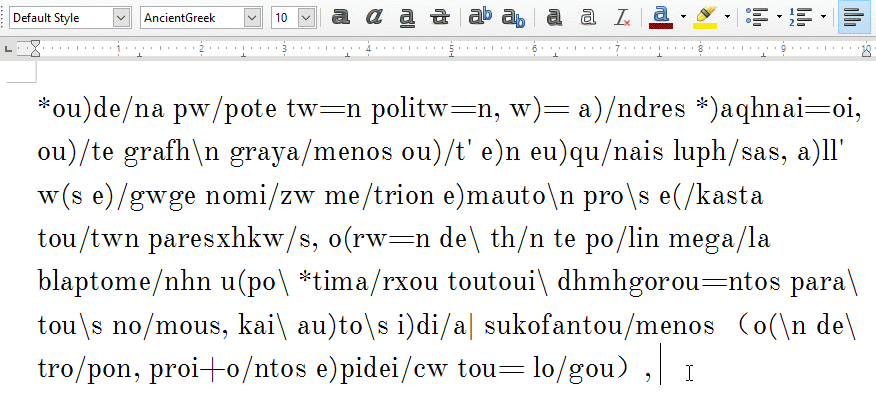Carattere AncientGreekBetaCode
AncientGreekBetaCode font is an implementation of the AncientGreek TrueType font, which uses an advanced OpenType typography feature called Glyph Substitution (GSUB) in order to make it possible to render Beta Code encoded text as it would appear when decoded.
The difference from previous relevant implementations (such as the BetaRead font), is that it is able to render capital letters and compound Beta Code symbols as well as small letters, while correctly rendering Ancient Greek text in Unicode at the same time.
It actually behaves as a Beta Code to Unicode converter of a kind, acting at a very low level (font rendering), substituting ASCII glyphs (and their combinations) with Ancient Greek Unicode glyphs, without affecting the underlaid text.
But there is a catch: it does not work everywhere. The result depends on the support provided by the Operating System plus the program used to render the text (both of them must support Glyph Substitution):
- If you are on Windows XP or 7, you can just stop reading at this point; none of these Operating Systems support Glyph Substitution.
- If OpenOffice is your program of choice, unless you are on a Mac, you can stop here; the latest version of the program at the time of writing this page (version 4.1.2) does not seem to support Glyph Substitution on Windows and Linux.
In any other case, you can download and use the AncientGreek Beta Code font to display Beta Code text; you could even use it to type Ancient Greek text on a simple editor (such as Windows Avvisopad) and have it converted to Unicode at a later time.

Carattere AncientGreekBetaCode
To be a more technical about it, the font uses an Opentype feature called Ligature Substitution, Glyph Composition/Decomposition (ccmp), which is responsible for performing all the Glyph Substitution taking place when rendering Beta Code text using the font. And it depends on this feature's support that will make the font work or not.
The results of the test I've performed are shown in the following table:
| Windows XP & 7 |
Windows 8 & 10 |
Mac OS X (Yosemite) |
Debian Linux |
Linux (Manjaro, PCLOS) |
|
|---|---|---|---|---|---|
| LO | X | √ | √ | √ (4.3.3.2) |
√ |
| AOO | X | X | √ (4.1.1) |
X | X |
| Editor | X | √ (Avvisopad) |
√ (TextEdit) |
√ (gEdit) |
√ (gEdit) |
Comments on preforming the tests:
- I have used the latest version of each program (unless stated otherwise).
- I have included a "simple text editor test", such as Avvisopad, TextEdit and gEdit, to check general availability of the font.
A proposito del tipo di carattere^
The font name is AncientGreekBetaCode but whenever font preview is used, for example in LibreOffice font selection drop-down menu, ανξιεντγρεεκβεταξοδε will be shown (which is the font name converted to Beta Code), as can be seen in the following animation.

The font in action on Windows 10
The following conventions apply:
- The font is in accordance with AncientGreek Logica di applicazione del Beta Code.
- "s", "S", "j" and "J" will always produce a Sigma finale ("ς").
- Sigma finale ("ς") followed any letter of an apostrophe or a daseia (rough breathing), will be converted to a medial sigma ("σ").
- Neither "s1" nor "S1" can be used for medial sigma ("σ").
- Stand-alone precomposed breathing and punctuation symbols are always used. For example it a parenthesis ")" is typed at the beginning of a paragraph or after a space character, a psili "᾿" will be displayed.
- Several characters (mainly parenthesis) are hard to insert, especially when followed by a number, because of its function within the Beta Code encoding. If needed, their fullwidth forms should be inserted.
| Tipo di carattere | Fullwidth form | |
|---|---|---|
| Left and Right Parenthesis | U+FF08 | U+FF09 |
| Left and Right Square Bracket | U+FF3B | U+FF3D |
- Our video tutorial will guide you through the process of inserting a unicode character with the keyboard.
